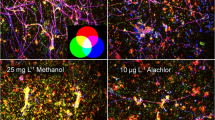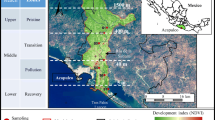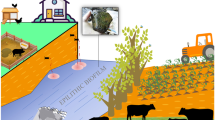Abstract
Microorganisms play key roles in stream ecosystems, but comparatively little is known about the resilience of freshwater bacterial communities and their susceptibility to the chemical by-products of agricultural land use. Antibiotics used in the agricultural sector are of particular concern and have been detected in waterways associated with agricultural land. Despite widespread agricultural intensification globally and the sector's high antibiotic use, the effects of agricultural antibiotic by-products on stream microbial communities have yet to be characterised. We investigated the impacts of the antibiotic monensin on microbial biofilm communities in a simulated contamination event using streamside-replicated channels. A 24-h pulse experiment in flow channels precolonised by stream biofilm microbial communities contrasted the effects of monensin concentrations ranging from realistic to extreme toxicity levels (1–550 ug L−1). Biofilm community composition was characterised immediately before and after the pulse for several weeks using automated ribosomal intergenic spacer analysis. Despite applying acutely toxic levels of monensin, only limited effects to biofilm community composition were detected immediately after antibiotic application, and these disappeared within 4 days. Rather, temporal factors drove biofilm differences, highlighting the overriding importance of wider, catchment-level, physiochemical hydrological influences on structuring freshwater biofilm communities, as opposed to localised and sporadic agricultural surface runoff contamination events containing antibiotics.




Similar content being viewed by others
References
American Public Health Association (1998) Standard methods for the examination of water and wastewater, 20th edn. American Public Health Association, Washington D.C., USA
Anderson M, Gorley R, Clarke K (2008) PERMANOVA + for PRIMER: guide to software and statistical methods. PRIMER-E Ltd., Plymouth, United Kingdom
Anderson-Glenna M, Bakkestuen V, Clipson N (2008) Spatial and temporal variability in epilithic biofilm bacterial communities along an upland river gradient. FEMS Microbiol Ecol 64:407–418
Bassin J, Pronk M, Muyzer G, Kleerebezem R, Dezotti M, van Loosdrecht M (2011) Effect of elevated salt concentrations on the aerobic granular sludge process: linking microbial activity with microbial community structure. Appl Environ Microbiol. doi:10.1128/AEM.05016-11
Battin T, Kaplan L, Newbold J, Cheng X, Hansen C (2003) Effects of current velocity on the nascent architecture of stream microbial biofilms. Appl Environ Microbiol 69:5443–5452
Berninger U, Finlay B, Kuuppo-Leinikki P (1991) Protozoan control of bacterial abundances in freshwater. Limnol Oceanogr 36:139–147
Besemer K, Peter H, Logue J, Langenheder S, Lindström E, Tranvik L, Battin T (2012) Unraveling assembly of stream biofilm communities. ISME J 6:1459–1468
Bott T, Kaplan L (1985) Bacterial biomass, metabolic state, and activity in stream sediments: relation to environmental variables and multiple assay comparisons. Appl Environ Microbiol 50:508–522
Castiglioni S, Bagnati R, Calamari D, Fanelli R, Zuccato E (2005) A multiresidue analytical method using solid-phase extraction and high-pressure liquid chromatography tandem mass spectrometry to measure pharmaceuticals of different therapeutic classes in urban wastewaters. J Chromatogr A 1092:206–215
Choung C, Hyne R, Stevens M, Hose G (2013) The ecological effects of a herbicide–insecticide mixture on an experimental freshwater ecosystem. Environ Pollut 172:264–274
Costanzo S, Murby J, Bates J (2005) Ecosystem response to antibiotics entering the aquatic environment. Mar Pollut Bull 51:218–223
Das M, Royer T, Leff L (2007) Diversity of fungi, bacteria, and actinomycetes on leaves decomposing in a stream. Appl Environ Microbiol 73:756–767
Davis B, Luger S, Tai P (1986) Role of ribosome degradation in the death of starved Escherichia coli cells. J Bacteriol 166:439–445
D'Costa V, McGrann K, Hughes D, Wright G (2006) Sampling the antibiotic resistome. Science 311:374–377
Dolliver H, Kumar K, Gupta S, Singh A (2008) Application of enzyme-linked immunosorbent assay analysis for determination of monensin in environmental samples. J Environ Qual 137:1220–1226
Donlan R, Costerton J (2002) Biofilms: survival mechanisms of clinically relevant microorganisms. Clin Microbiol Rev. doi:10.1128/CMR.15.2.167-193.2002
Donoho A (1984) Biochemical studies on the fate of monensin in animals and in the environment. J Anim Sci 58:1528–1539
Dosskey M (2001) Toward quantifying water pollution abatement in response to installing buffers on crop land. Environ Manag 28:577–598
ELANCO Rumensin Trough Treatment MSDS (2007) Eli Lilly and Company NZ Limited, Auckland, New Zealand
Elliot J, Irish A, Reynolds C (2000) The diversity and succession of phytoplankton communities in disturbance-free environments, using the model PROTECH. Arch Hydrobiol 149:251–258
Engemann C, Keen P, Knapp C, Hall K, Graham D (2008) Fate of tetracycline resistance genes in aquatic systems: migration from the water column to peripheral biofilms. Environ Sci Technol 42:5131–5136
Feris K, Ramsey P, Frazer C, Rillig M, Gannon J, Holben B (2003) Structure and seasonal dynamics of hyporheic zone microbial communities in free-stone rivers of western United States. Microb Ecol 46:200–215
Finlay S, Strayer D, Goumbala C, Gould K (1993) Metabolism of streamwater dissolved organic carbon in the shallow hyporheic zone. Limnol Oceanogr 38:1493–1499
Fisher M, Triplett E (1999) Automated approach for ribosomal intergenic spacer analysis of microbial diversity of microbial diversity and its applications to freshwater bacterial communities. Appl Environ Microbiol 65:4630–4636
Gillevet P, Sikaroodi M, Torzilli A (2009) Analyzing salt-marsh fungal diversity: comparing ARISA fingerprinting with clone sequencing and pyrosequencing. Fungal Ecol 2:160–167
Halling-Sørensen B, Nors Nielsen S, Lanzky P, Ingerslev F, Holten Lützhøft H, Jørgensen S (1998) Occurrence, fate and effects of pharmaceutical substances in the environment—a review. Chemosphere 36:357–393
Hansen M, Krogh K, Björkland E, Brandt A, Halling-Sørensen B (2009) Environmental risk assessment of ionophores. Trends Anal Chem 28:534–542
Herrmann P (2009) Disturbance, predation and competition in a flood-prone stream. PhD Dissertation. University of Otago, New Zealand
Hillis D, Lissemore L, Sibley P, Solomon K (2007) Effects of monensin on zooplankton communities in aquatic microcosms. Environ Sci Technol 41:6620–6626
Jackson C, R (2001) Successional changes in bacterial assemblage structure during epilithic biofilm development. Ecology 82:555–566
Kemper N (2008) Veterinary antibiotics in the aquatic and terrestrial environment. Ecol Indic 8:1–13
Khachatourians G (1998) Agricultural use of antibiotics and the evolution and transfer of antibiotic-resistant bacteria. Can Med Assoc J 159:1129–1136
Lamberti G, Resh V (1985) Comparability of introduced tiles and natural substrates for sampling lotic bacteria, algae, and macro-invertebrates. Freshwat Biol 15:21–30
Lange K, Liess A, Piggott J, Townsend C, Matthaei C (2011) Light, nutrients and grazing interact to determine stream diatom community composition and functional group structure. Freshwat Biol 56:264–278
Lapworth D, Baran N, Stuart M, Ward R (2012) Emerging organic contaminants in groundwater: a review of sources, fate and occurrence. Environ Pollut 163:287–303
Lear G, Anderson M, Smith J, Boxen K, Lewis G (2008) Spatial and temporal heterogeneity of the bacterial communities in stream epilithic biofilms. FEMS Microb Ecol 65:463–473
LIC (2007) Dairy statistics 2006-2007. Livestock Improvement Corporation, Hamilton, New Zealand
Liess A, Lange K, Schulz F, Piggott J, Matthaei C, Townsend C (2008) Light, nutrients and grazing interact to determine diatom species richness via changes to productivity, nutrient state and grazer activity. J Ecol. doi:10.1111/j.1365-2745.2008.01463.x
Lissemore L, Hao C, Yang P, Sibley P, Mabury S, Solomon K (2006) An exposure assessment for selected pharmaceuticals within a watershed in Southern Ontario. Chemosphere 64:717–729
Loudon A, Woodhams D, Wegener Parfrey L, Archer H, Knight R, McKenzie V, Harris R (2013) Microbial community dynamics and effect of environmental microbial reservoirs on red-backed salamanders (Plethodon cinereus). ISME J. doi:10.1038/ismej.2013.163
Lyautey E, Jackson C, Cayrou J, Rols J, Garabétian F (2005) Bacterial community succession in natural river biofilm assemblages. Microb Ecol 50:589–601
Matthaei C, Piggott J, Townsend C (2010) Multiple stressors in agricultural streams: interactions among sediment addition, nutrient enrichment and water abstraction. J Appl Ecol 47:639–649
Mawdsley J, Bardgett R, Merry R, Pain B, Theodorou M (1995) Pathogens in livestock waste, their potential for movement through soil and environmental pollution. Appl Soil Ecol 2:1–15
McGregor E, Solomon K, Hanson M (2007) Monensin is not toxic to aquatic macrophytes at environmentally relevant concentrations. Arch Environ Contam Toxicol 53:541–551
Morgenroth E, Wilder P (2000) Influence of detachment mechanisms on competition in biofilms. Water Res 34:417–426
Muirhead R, Collins R, Bremer P (2006) The association of E. coli and soil particles in overland flow. Water Sci Technol 54:153–159
Murray K, Thomas S, Bodour A (2010) Prioritizing research for trace pollutants and emerging contaminants in the freshwater environment. Environ Pollut. doi:3462e3471
Neidhardt F, Magasanik B (1960) Studies on the role of ribonucleic acid in the growth of bacteria. Biochim Biophys Acta 42:99–116
PCE (2004) Growing for good: intensive farming, sustainability and New Zealand's environment. Parliamentary Commissioner for the Environment. Wellington, New Zealand
Pesce S, Martin-Laurent F, Rouard N, Robin A, Montuelle B (2010) Evidence for adaptation of riverine sediment microbial communities to diuron mineralization: incidence of and soil erosion. J Soils Sediments 10:698–707
Piggott J, Lange K, Townsend C, Matthaei C (2012) Multiple stressors in agricultural streams: a mesocosm study of interactions along raised water temperature, sediment addition and nutrient enrichment. PLoS 7:e49873
Pusch M, Fiebig D, Brettar I, Eisenmann H, Ellis B, Kaplan L, Lock M, Naegeli M, Traunspurger W (1998) The role of micro-organisms in the ecological connectivity of running waters. Freshwat Biol 40:453–495
Ranjard L, Poly F, Lata J, Mougal C, Thioulouse J, Nazaret S (2001) Characterization of bacterial and fungal soil communities by automated ribosomal intergenic spacer analysis fingerprints: biological and methodological variability. Appl Environ Microbiol 67:4479–4487
Römling U, Balsalobre C (2012) Biofilm infections, their resilience to therapy and innovative treatment strategies. J Intern Med. doi:10.1111/joim.12004
Russell J, Houlihan A (2003) Ionophore resistance of ruminal bacteria and its potential impact on human health. FEMS Microbiol Rev 27:65–74
Sabater S, Guasch A, Romaní H, Muñoz I (2002) The effect of biological factors in the efficiency of river biofilms in improving water quality. Hydrobiologica 469:149–156
Salis R (2010) The effects of the agricultural antibiotic monensin, dairy effluent and light in stream algal communities. BSc Honours Dissertation. University of Otago, New Zealand
Sarmah A, Meyer M, Boxall A (2006) A global perspective on the use, sales, exposure pathways, occurrence, fate and effects of veterinary antibiotics (VAs) in the environment. Chemosphere 65:725–759
Schmeisser C, Steele H, Streit W (2007) Metagenomics, biotechnology with non-culturable microbes. Appl Microbiol Biotechnol 75:955–962
Searle S, Casella G, McCulloch C (1992) Variance components. Wiley, New York, USA
Sigee D (2005) Freshwater microbiology: biodiversity and dynamic interactions of microorganisms in the aquatic environment. Wiley, Hoboken, USA
Snow D, Bartelt-Hunt S, Saunders S, Devivo S, Cassada D (2008) Detection, occurrence and fate of emerging contaminants in agricultural environments. Water Environ Res 80:868–897
Song W, Huang M, Rumbeiha W, Li H (2007) Determination of amprolium, carbadox, monensin, and tylosin in surface water by liquid chromatography/tandem mass spectrometry. Rapid Commun Mass Spectrom 21:1944–1950
Stewart P, Costerton J (2001) Antibiotic resistance of bacteria in biofilms. Lancet 358:135–138
Telgmann U, Horn H, Morgenroth E (2004) Influence of growth history on sloughing and erosion from biofilms. Water Res 38:3671–3684
Wagenhoff A, Townsend C, Matthaei C (2012) Macroinvertebrate responses along broad stressor gradients of deposited fine sediment and dissolved nutrients: a stream mesocosm experiment. J Appl Ecol 49:892–902
Watanabe N, Harter T, Bergamaschi B (2008) Environmental occurrence and shallow ground water detection of the antibiotic monensin from dairy farms. J Environ Qual 37:S-78–S-85
Watkinson A, Murby E, Kolpin D, Costanzo S (2009) The occurrence of antibiotics in an urban watershed: from wastewater to drinking water. Sci Total Environ. doi:10.1016/j.scititenv.2008.1011.1059
Wellnitz T, Brader R (2003) Mechanisms influencing community composition and succession in mountain stream periphyton: interactions between scouring history, grazing and irradiance. J N Am Benthol Soc 22:528–541
Winkworth C (2013) Antibiotic resistance genes in freshwater biofilms along a whole river. J Water Health. doi:10.2166/wh.2013.223
Winkworth C, Matthaei C, Townsend C (2008) Recently planted vegetation strips reduce Giardia runoff reaching waterways. J Environ Qual. doi:10.2134/jeq2008.0045
Yergeau E, Sanschagrin S, Maynard C, St-Arnaud M, Greer C (2014) Microbial expression profiles in the rhizosphere of willows depend on soil contamination. ISME J. doi:10.1038/ismej.2013.163
Young R, Matthaei C, Townsend C (2008) Organic matter breakdown and ecosystem metabolism: functional indicators for assessing river ecosystem health. J N Am Benthol Soc 27:605–625
Acknowledgments
This work was supported by a New Zealand Research, Science and Technology Postdoctoral Fellowship to CLW (UOOX0902). We thank Colin Townsend and three anonymous reviewers for editorial suggestions, and Alicia Farmer, Katha Lange, Lauren Leicester and Romana Salis for assistance with field collections and laboratory work.
Author information
Authors and Affiliations
Corresponding author
Additional information
Responsible editor: Robert Duran
Rights and permissions
About this article
Cite this article
Winkworth, C.L., Lear, G. Antimicrobial potential of the ionophore monensin on freshwater biofilm bacteria. Environ Sci Pollut Res 21, 10139–10150 (2014). https://doi.org/10.1007/s11356-014-2911-y
Received:
Accepted:
Published:
Issue Date:
DOI: https://doi.org/10.1007/s11356-014-2911-y




